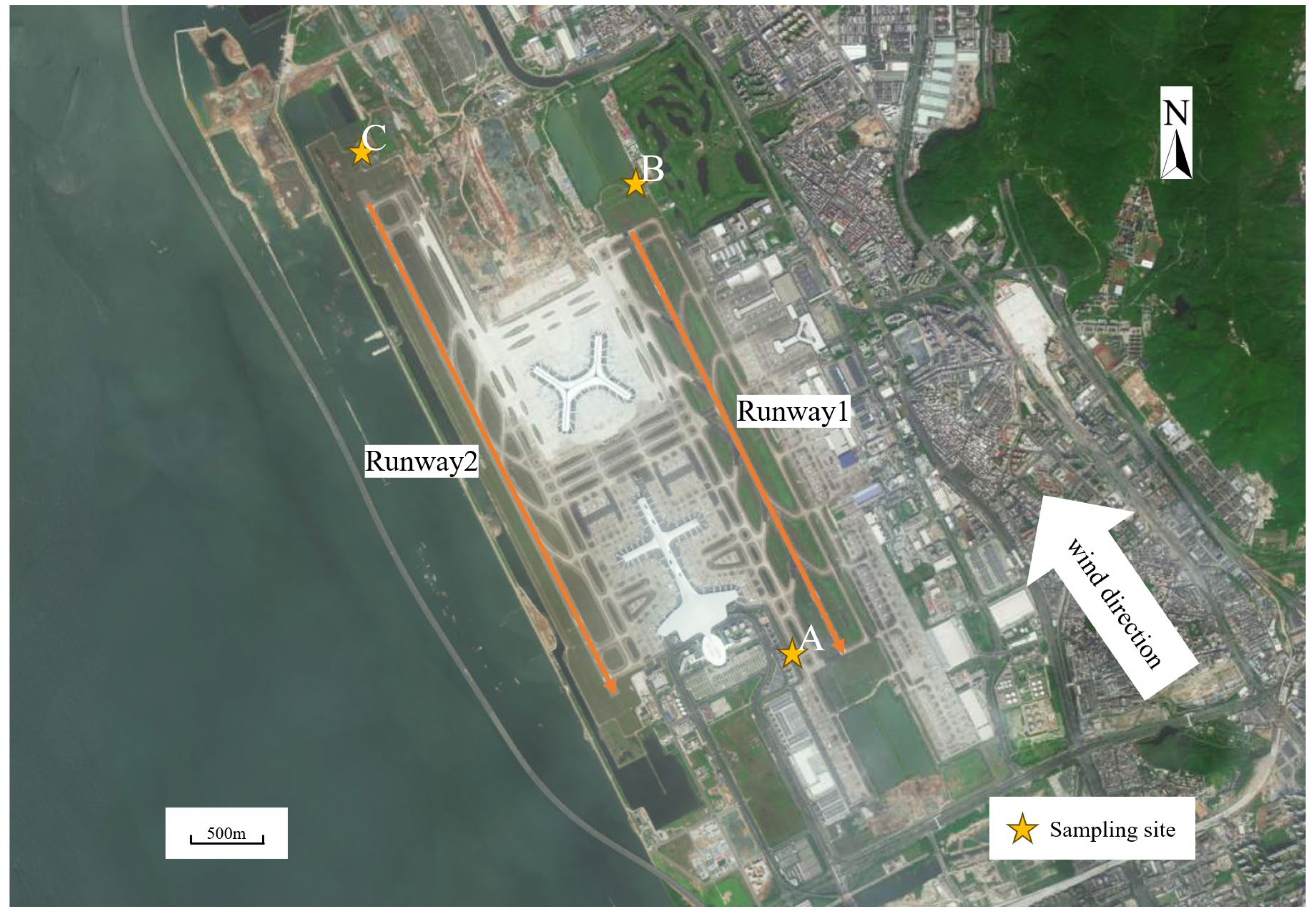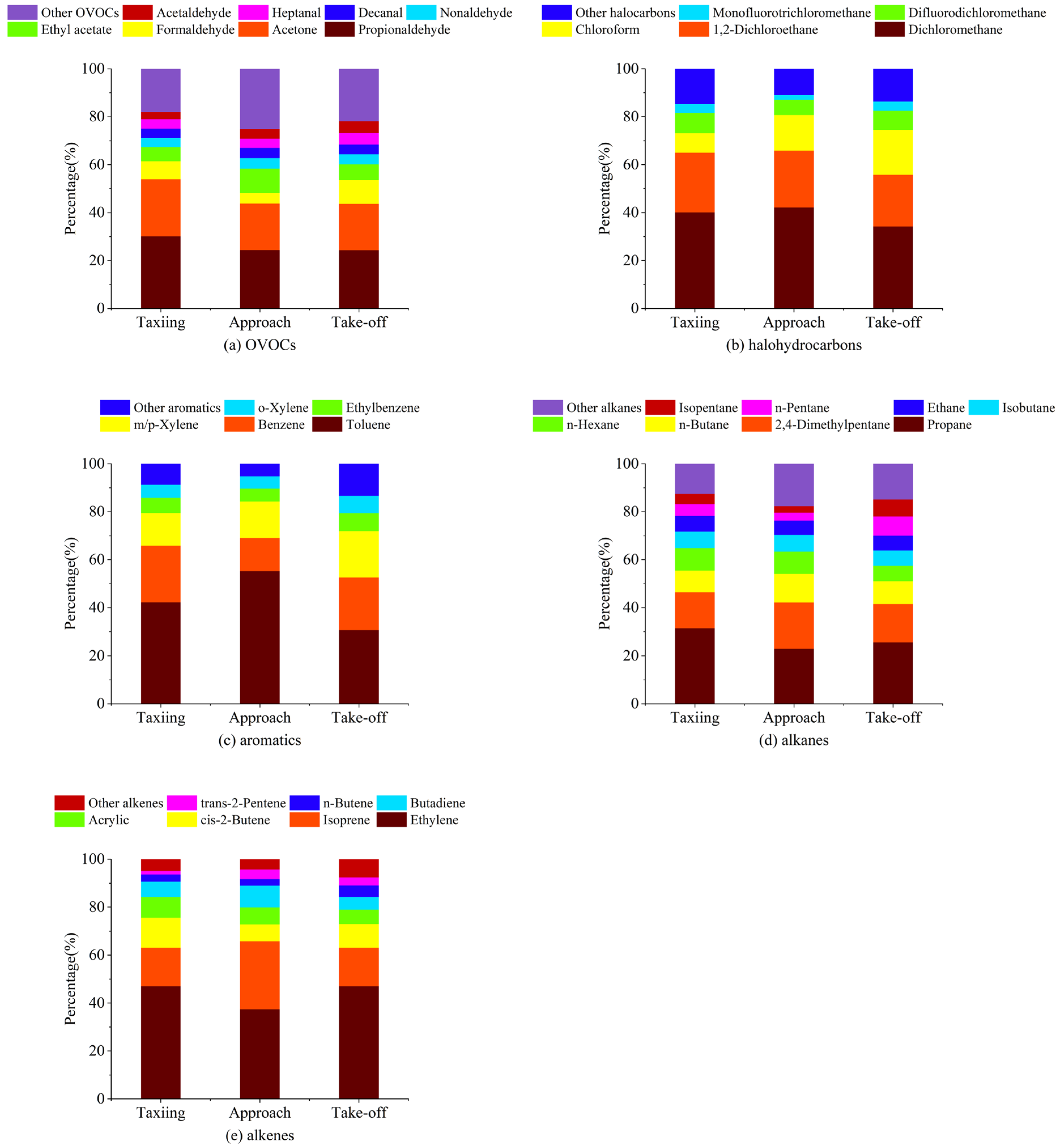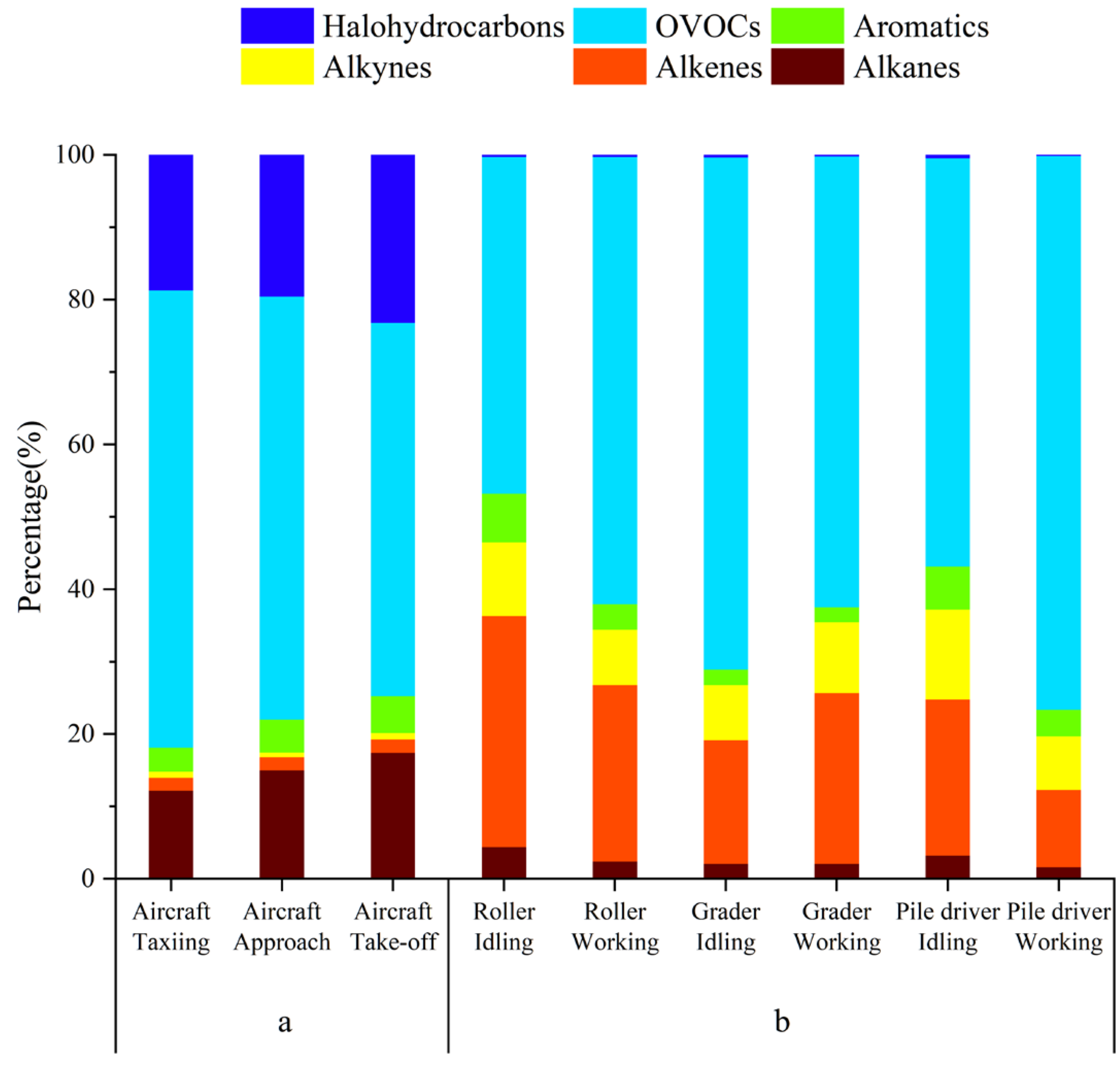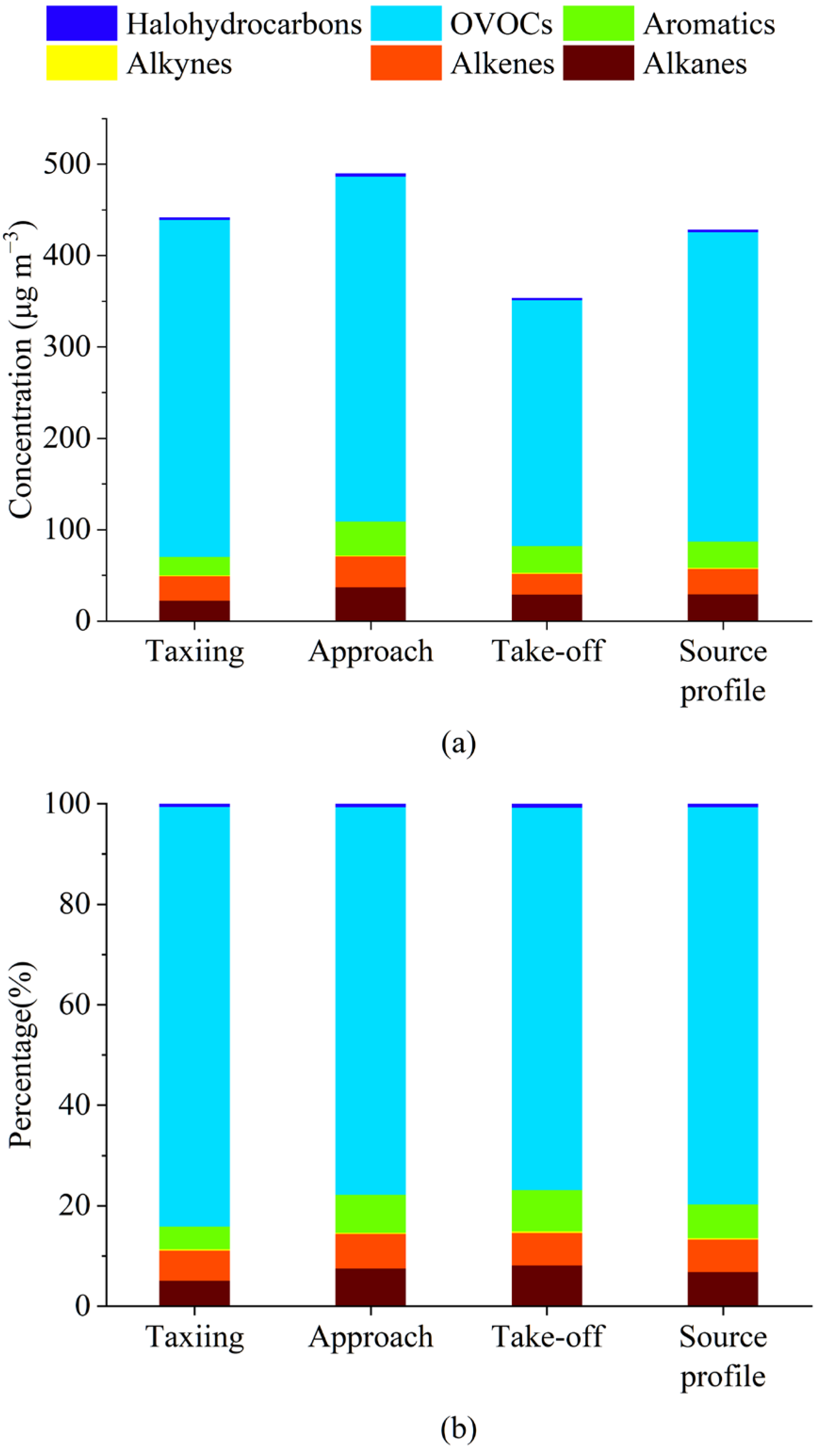Characteristics of Volatile Organic Compounds Emitted from Airport Sources and Their Effects on Ozone Production
Abstract
1. Introduction
2. Methods
2.1. Sample Collection
2.2. Analysis of VOCs and OVOCs
2.3. Calculation of Ozone Formation Potential
3. Results and Discussion
3.1. Characteristics of VOCs Emitted at Different Flight States
3.2. Distribution Characteristics of VOCs Emitted from Airport Sources
3.2.1. Composition Characteristics of the Main Chemical Components of Each Type of VOC
3.2.2. Comparison with Other Mobile Sources
3.3. Concentration Characteristics of the Main VOCs Emitted by Aircraft during Different Operating States
3.4. Source Profile Characteristics of Aircraft Emissions
3.5. Comparison of OFP Values in Different Operating States
4. Conclusions
Supplementary Materials
Author Contributions
Funding
Institutional Review Board Statement
Informed Consent Statement
Data Availability Statement
Conflicts of Interest
References
- Kley, D.; Kleinmann, M.; Sanderman, H.; Krupa, S. Photochemical oxidants: State of the science. Environ. Pollut. 1999, 100, 19–42. [Google Scholar] [CrossRef] [PubMed]
- Mellouki, A.; Wallington, T.; Chen, J. Atmospheric chemistry of oxygenated volatile organic compounds: Impacts on air quality and climate. Chem. Rev. 2015, 115, 3984–4014. [Google Scholar] [CrossRef]
- Qu, H.; Wang, Y.; Zhang, R.; Liu, X.; Huey, L.G.; Sjostedt, S.; Zeng, L.; Lu, K.; Wu, Y.; Shao, M. Chemical production of oxygenated volatile organic compounds strongly enhances boundary-layer oxidation chemistry and ozone production. Environ. Sci. Technol. 2021, 55, 13718–13727. [Google Scholar] [CrossRef]
- Louie, P.K.K.; Ho, J.W.K.; Tsang, R.C.W.; Blake, D.R.; Lau, A.K.H.; Yu, J.Z.; Yuan, Z.; Wang, X.; Shao, M.; Zhong, L. VOCs and OVOCs distribution and control policy implications in Pearl River Delta region, China. Atmos. Environ. 2013, 76, 125–135. [Google Scholar] [CrossRef]
- Tang, B.-J.; Li, X.-Y.; Yu, B.; Wei, Y.-M. Sustainable development pathway for intercity passenger transport: A case study of China. Appl. Energy 2019, 254, 113632. [Google Scholar] [CrossRef]
- Gong, Q.; Wang, K.; Fan, X.; Fu, X.; Xiao, Y.-b. International trade drivers and freight network analysis—The case of the Chinese air cargo sector. J. Transp. Geogr. 2018, 71, 253–262. [Google Scholar] [CrossRef]
- İnan, T.T. Recovery Period of Air Transportation: Vector Error Correction Model. RT&A 2023, 18, 589–606. [Google Scholar] [CrossRef]
- Liu, W.M.; Luk, M.K.R. Reform and opening up: Way to the sustainable and harmonious development of air transport in China. Transp. Policy 2009, 16, 215–223. [Google Scholar] [CrossRef]
- Tsilingiridis, G. Aircraft air pollutant emissions in Greek airports. Glob. Nest J. 2009, 11, 528–534. [Google Scholar]
- Board, T.R.; National Academies of Sciences, E. Medicine. In Airport Air Quality Management 101; The National Academies Press: Washington, DC, USA, 2018; p. 68. [Google Scholar]
- Unal, A.; Hu, Y.; Chang, M.E.; Talat Odman, M.; Russell, A.G. Airport related emissions and impacts on air quality: Application to the Atlanta International Airport. Atmos. Environ. 2005, 39, 5787–5798. [Google Scholar] [CrossRef]
- Daniels, A.; Bach, W. Simulation of the environmental impact of an airport on the surrounding air quality. J. Air Pollut. Control Assoc. 1976, 26, 339–344. [Google Scholar] [CrossRef]
- Zhu, Y.; Fanning, E.; Yu, R.C.; Zhang, Q.; Froines, J.R. Aircraft emissions and local air quality impacts from takeoff activities at a large International Airport. Atmos. Environ. 2011, 45, 6526–6533. [Google Scholar] [CrossRef]
- Wang, K.; Wang, X.; Cheng, S.; Cheng, L.; Wang, R. National emissions inventory and future trends in greenhouse gases and other air pollutants from civil airports in China. Environ. Sci. Pollut. Res. 2022, 29, 81703–81712. [Google Scholar] [CrossRef]
- Mazaheri, M.; Johnson, G.R.; Morawska, L. An inventory of particle and gaseous emissions from large aircraft thrust engine operations at an airport. Atmos. Environ. 2011, 45, 3500–3507. [Google Scholar] [CrossRef]
- Winther, M.; Kousgaard, U.; Ellermann, T.; Massling, A.; Nøjgaard, J.K.; Ketzel, M. Emissions of NOx, particle mass and particle numbers from aircraft main engines, APU’s and handling equipment at Copenhagen Airport. Atmos. Environ. 2015, 100, 218–229. [Google Scholar] [CrossRef]
- Yang, X.; Cheng, S.; Lang, J.; Xu, R.; Lv, Z. Characterization of aircraft emissions and air quality impacts of an international airport. J. Environ. Sci. 2018, 72, 198–207. [Google Scholar] [CrossRef] [PubMed]
- Schürmann, G.; Schäfer, K.; Jahn, C.; Hoffmann, H.; Bauerfeind, M.; Fleuti, E.; Rappenglück, B. The impact of NOx, CO and VOC emissions on the air quality of Zurich airport. Atmos. Environ. 2007, 41, 103–118. [Google Scholar] [CrossRef]
- Jung, K.-H.; Artigas, F.; Shin, J.Y. Personal, indoor, and outdoor exposure to VOCs in the immediate vicinity of a local airport. Environ. Monit. Assess. 2011, 173, 555–567. [Google Scholar] [CrossRef]
- Mokalled, T.; Adjizian Gérard, J.; Abboud, M.; Trocquet, C.; Nasreddine, R.; Person, V.; le Calvé, S. VOC tracers from aircraft activities at Beirut Rafic Hariri International Airport. Atmos. Pollut. Res. 2019, 10, 537–551. [Google Scholar] [CrossRef]
- Herndon, S.C.; Wood, E.C.; Northway, M.J.; Miake-Lye, R.; Thornhill, L.; Beyersdorf, A.; Anderson, B.E.; Dowlin, R.; Dodds, W.; Knighton, W.B. Aircraft hydrocarbon emissions at Oakland international airport. Environ. Sci. Technol. 2009, 43, 1730–1736. [Google Scholar] [CrossRef]
- Lai, C.-H.; Chuang, K.-Y.; Chang, J.-W. Source apportionment of volatile organic compounds at an international airport. Aerosol Air Qual. Res. 2013, 13, 689–698. [Google Scholar] [CrossRef]
- Yang, X.; Cheng, S.; Wang, G.; Xu, R.; Wang, X.; Zhang, H.; Chen, G. Characterization of volatile organic compounds and the impacts on the regional ozone at an international airport. Environ. Pollut. 2018, 238, 491–499. [Google Scholar] [CrossRef]
- Sheng, J.; Wang, F.; Li, X.; Zhou, W.; Zhao, D.; Liu, Q.; Tian, P.; Huang, M.; Ding, D. The proton transfer reaction time of flight mass spectrometer (PTR-TOF-MS) analysis of the turboprop aircraft emission of VOCs. Acta Sci. Circumstantiae 2021, 41, 1784–1791. [Google Scholar] [CrossRef]
- Xu, H.; Xiao, K.; Pan, J.; Fu, Q.; Wei, X.; Zhou, J.; Yu, Y.; Hu, X.; Ren, H.; Cheng, J.; et al. Evidence of aircraft activity impact on local air quality: A study in the context of uncommon airport operation. J. Environ. Sci. 2023, 125, 603–615. [Google Scholar] [CrossRef] [PubMed]
- Zhu, B.; Cao, L.-M.; Xia, S.-Y.; Niu, Y.-B.; Man, H.-Y.; Du, K.; Yu, K.; Huang, X.-F. Identifying the airport as a key urban VOC source in the Pearl River Delta, China. Atmos. Environ. 2023, 301, 119721. [Google Scholar] [CrossRef]
- Jiang, C.; Pei, C.; Cheng, C.; Shen, H.; Zhang, Q.; Lian, X.; Xiong, X.; Gao, W.; Liu, M.; Wang, Z.; et al. Emission factors and source profiles of volatile organic compounds from typical industrial sources in Guangzhou, China. Sci. Total Environ. 2023, 869, 161758. [Google Scholar] [CrossRef] [PubMed]
- Venecek, M.A.; Carter, W.P.; Kleeman, M.J. Updating the SAPRC Maximum Incremental Reactivity (MIR) scale for the United States from 1988 to 2010. J. Air Waste Manag. Assoc. 2018, 68, 1301–1316. [Google Scholar] [CrossRef] [PubMed]
- ICAO. Aircraft Engine Emissions Databank. Int. Civ. Aviat. Organ. 2006. [Google Scholar]
- Spicer, C.W.; Holdren, M.W.; Cowen, K.A.; Joseph, D.W.; Satola, J.; Goodwin, B.; Mayfield, H.; Laskin, A.; Lizabeth Alexander, M.; Ortega, J.V.; et al. Rapid measurement of emissions from military aircraft turbine engines by downstream extractive sampling of aircraft on the ground: Results for C-130 and F-15 aircraft. Atmos. Environ. 2009, 43, 2612–2622. [Google Scholar] [CrossRef]
- Yelvington, P.E.; Herndon, S.C.; Wormhoudt, J.C.; Jayne, J.T.; Miake-Lye, R.C.; Knighton, W.B.; Wey, C. Chemical speciation of hydrocarbon emissions from a commercial aircraft engine. J. Propuls. Power 2007, 23, 912–918. [Google Scholar] [CrossRef]
- Agrawal, H.; Sawant, A.A.; Jansen, K.; Miller, J.W.; Cocker III, D.R. Characterization of chemical and particulate emissions from aircraft engines. Atmos. Environ. 2008, 42, 4380–4392. [Google Scholar] [CrossRef]
- Anderson, B.E.; Chen, G.; Blake, D.R. Hydrocarbon emissions from a modern commercial airliner. Atmos. Environ. 2006, 40, 3601–3612. [Google Scholar] [CrossRef]
- Lelievre, C.P. La Qualité de L’air en Milieu Aéroportuaire: Étude Sur L’aéroport Paris-Charles-De-Gaulle; Université Paris-Est: Paris, France, 2009. [Google Scholar]
- Spicer, C.; Holdren, M.; Riggin, R.; Lyon, T. Chemical composition and photochemical reactivity of exhaust from aircraft turbine engines. Ann. Geophys. 1994, 12, 944–955. [Google Scholar] [CrossRef]
- Beyersdorf, A.J.; Thornhill, K.L.; Winstead, E.L.; Ziemba, L.D.; Blake, D.R.; Timko, M.T.; Anderson, B.E. Power-dependent speciation of volatile organic compounds in aircraft exhaust. Atmos. Environ. 2012, 61, 275–282. [Google Scholar] [CrossRef]
- Guan, J.; Wang, C.; Gao, K.; Yang, X.; Lin, C.-H.; Lu, C. Measurements of volatile organic compounds in aircraft cabins. Part II: Target list, concentration levels and possible influencing factors. Build. Environ. 2014, 75, 170–175. [Google Scholar] [CrossRef]
- Xia, S.-Y.; Wang, C.; Zhu, B.; Chen, X.; Feng, N.; Yu, G.-H.; Huang, X.-F. Long-term observations of oxygenated volatile organic compounds (OVOCs) in an urban atmosphere in southern China, 2014–2019. Environ. Pollut. 2021, 270, 116301. [Google Scholar] [CrossRef]
- McCulloch, A.; Aucott, M.L.; Graedel, T.E.; Kleiman, G.; Midgley, P.M.; Li, Y.F. Industrial emissions of trichloroethene, tetrachloroethene, and dichloromethane: Reactive Chlorine Emissions Inventory. J. Geophys. Res. Atmos. 1999, 104, 8417–8427. [Google Scholar] [CrossRef]
- MacGregor, I.; Buehler, S.; Spicer, C. Concentrations of selected chemical species in the airliner cabin environment. J. ASTM Int. 2008, 5, JAI101639. [Google Scholar] [CrossRef]
- Yin, Y.; He, J.; Zhao, L.; Pei, J.; Yang, X.; Sun, Y.; Cui, X.; Lin, C.-H.; Wei, D.; Chen, Q. Identification of key volatile organic compounds in aircraft cabins and associated inhalation health risks. Environ. Int. 2022, 158, 106999. [Google Scholar] [CrossRef] [PubMed]
- Sekar, A.; Varghese, G.K.; Varma, M.R. Chloroform—An Emerging Pollutant in the Air. In New Trends in Emerging Environmental Contaminants; Springer: Berlin/Heidelberg, Germany, 2021; pp. 101–129. [Google Scholar] [CrossRef]
- Lelièvre, C.P.; Magnani, G.; Ramaroson, R.; Gouriou, F.; Talbaut, M.; Fréjafon, E.; Schuermann, G.; Schaefer, K.; Cornier, I.; Emeis, S. Air quality and engine emission at Paris CDG airport during AIRPUR field campaigns. WIT Trans. Ecol. Environ. 2006, 86, 16. [Google Scholar]
- Guimarães, C.; Arbilla, G.; Corrêa, S.; Gatti, L. Impact of aircraft traffic emissions on ozone formation at the Rio de Janeiro urban area. Periódico Tchê Química 2007, 4, 21. [Google Scholar] [CrossRef]
- Wang, R.; Yuan, Z.; Zheng, J.; Li, C.; Huang, Z.; Li, W.; Xie, Y.; Wang, Y.; Yu, K.; Duan, L. Characterization of VOC emissions from construction machinery and river ships in the Pearl River Delta of China. J. Environ. Sci. 2020, 96, 138–150. [Google Scholar] [CrossRef] [PubMed]
- Wang, S.; Yuan, B.; Wu, C.; Wang, C.; Li, T.; He, X.; Huangfu, Y.; Qi, J.; Li, X.B.; Sha, Q.; et al. Oxygenated volatile organic compounds (VOCs) as significant but varied contributors to VOC emissions from vehicles. Atmos. Chem. Phys. 2022, 22, 9703–9720. [Google Scholar] [CrossRef]
- He, C.; Ge, Y.; Tan, J.; You, K.; Han, X.; Wang, J.; You, Q.; Shah, A.N. Comparison of carbonyl compounds emissions from diesel engine fueled with biodiesel and diesel. Atmos. Environ. 2009, 43, 3657–3661. [Google Scholar] [CrossRef]
- Yao, Z.; Shen, X.; Ye, Y.; Cao, X.; Jiang, X.; Zhang, Y.; He, K. On-road emission characteristics of VOCs from diesel trucks in Beijing, China. Atmos. Environ. 2015, 103, 87–93. [Google Scholar] [CrossRef]
- Nelson, P.F.; Tibbett, A.R.; Day, S.J. Effects of vehicle type and fuel quality on real world toxic emissions from diesel vehicles. Atmos. Environ. 2008, 42, 5291–5303. [Google Scholar] [CrossRef]
- Liu, Y.; Gao, Y.; Yu, N.; Zhang, C.; Wang, S.; Ma, L.; Zhao, J.; Lohmann, R. Particulate matter, gaseous and particulate polycyclic aromatic hydrocarbons (PAHs) in an urban traffic tunnel of China: Emission from on-road vehicles and gas-particle partitioning. Chemosphere 2015, 134, 52–59. [Google Scholar] [CrossRef] [PubMed]
- Pratt, G.; Herbrandson, C.; Krause, M.; Schmitt, C.; Lippert, C.; McMahon, C.; Ellickson, K. Measurements of gas and particle polycyclic aromatic hydrocarbons (PAHs) in air at urban, rural and near-roadway sites. Atmos. Environ. 2018, 179, 268–278. [Google Scholar] [CrossRef]
- Ofodile, J.; Alves, M.R.; Liang, Y.; Franklin, E.B.; Lunderberg, D.M.; Ivey, C.E.; Singer, B.C.; Nazaroff, W.W.; Goldstein, A.H. Characterizing PM2.5 Emissions and Temporal Evolution of Organic Composition from Incense Burning in a California Residence. Environ. Sci. Technol. 2024, 58, 5047–5057. [Google Scholar] [CrossRef]
- Du, W.; Yun, X.; Chen, Y.; Zhong, Q.; Wang, W.; Wang, L.; Qi, M.; Shen, G.; Tao, S. PAHs emissions from residential biomass burning in real-world cooking stoves in rural China. Environ. Pollut. 2020, 267, 115592. [Google Scholar] [CrossRef]
- Wei, H.; Guangbin, L.; Yong, T.; Qin, Z. Emission of polycyclic aromatic hydrocarbons from different types of motor vehicles’ exhaust. Environ. Earth Sci. 2015, 74, 5557–5564. [Google Scholar] [CrossRef]
- Carter, W.P. Reactivity Estimates for Selected Consumer Product Compounds; Final Report to the California Air Resources Board Contract No. 06-408; University of California: Riverside, CA, USA, 2008. [Google Scholar]






| Operating Status | Flight Number | Aircraft Type |
|---|---|---|
| Taxiing and take-off | CZ3587 | Airbus A330-343 |
| Taxiing and take-off | CZ5755 | Airbus A320-232 |
| Taxiing and take-off | ZH9429 | Boeing 737-87L |
| Taxiing and take-off | CZ6310 | Airbus A320-251N |
| Taxiing and take-off | MU5348 | Airbus A350-941 |
| Taxiing and take-off | MU5244 | Airbus A321-211 |
| Taxiing and take-off | ZH9887 | Boeing 737-87L |
| Taxiing and take-off | CZ3225 | Airbus A330-323 |
| Taxiing and take-off | CA1734 | Airbus A330-343 |
| Taxiing and take-off | TV9902 | Airbus A330-243 |
| Approach | 9C8775 | Airbus A321-253NX |
| Approach | CA1303 | Airbus A330-243 |
| Approach | MU2887 | Airbus A320-214 |
| Approach | DZ6242 | Boeing 737-8HX |
| Approach | ZH9210 | Airbus A320-271N |
| Approach | ZH9602 | Airbus A319-133 |
| Approach | HU7358 | Boeing 787-9 |
| Approach | ZH9104 | Airbus A320-271N |
| Approach | CZ6706 | Boeing 737-81B |
| Approach | CA4311 | Airbus A321-251NX |
| Emission Source | Analytical Method | OVOCs as a Percentage of Total VOCs | |
|---|---|---|---|
| Aircraft | GC-MS/FID and HPLC | 51.60–63.17% | This work |
| Roller | GC-MS/FID and HPLC | 60.10% | Wang et al. (2020) [45] |
| Grader | 63.00% | Wang et al. (2020) [45] | |
| Pile driver | 74.80% | Wang et al. (2020) [45] | |
| Gasoline car | GC-MS/FID and PTR-ToF-MS | 13% | Wang et al. (2022) [46] |
| Diesel car | 49% | Wang et al. (2022) [46] | |
| Liquefied petroleum gas vehicles | 58% | Wang et al. (2022) [46] | |
| Diesel truck | GC-MS/FID and HPLC | 42.7–69.2% | Yao et al. (2015) [47] |
| Operating Stage | Species | Concentration ± Standard Deviation (Unit: μg/m3) |
|---|---|---|
| Taxiing | Propionaldehyde | 29.32 ± 16.57 |
| Acetone | 23.36 ± 13.2 | |
| Dichloromethane | 11.62 ± 3.13 | |
| Formaldehyde | 7.35 ± 2.53 | |
| 1,2-Dichloroethane | 7.21 ± 2.59 | |
| Propane | 5.9 ± 2.29 | |
| Ethyl | 5.61 ± 1.69 | |
| Nonaldehyde | 3.89 ± 1.23 | |
| Decanal | 3.83 ± 0.84 | |
| Heptanal | 3.79 ± 0.73 | |
| Approach | Propionaldehyde | 27.42 ± 2.66 |
| Acetone | 21.85 ± 2.12 | |
| Dichloromethane | 15.87 ± 3.35 | |
| Ethyl | 11.37 ± 2.37 | |
| 1,2-Dichloroethane | 8.98 ± 3.05 | |
| Propane | 6.6 ± 1.8 | |
| Chloroform | 5.59 ± 4.03 | |
| 2,4-Dimethylpentane | 5.54 ± 3.13 | |
| 2-Butanone | 5.13 ± 1.11 | |
| Nonaldehyde | 5 ± 1.51 | |
| Take-off | Propionaldehyde | 16.58 ± 1.87 |
| Acetone | 13.22 ± 1.49 | |
| Dichloromethane | 10.49 ± 1.46 | |
| Formaldehyde | 6.77 ± 3.62 | |
| 1,2-Dichloroethane | 6.63 ± 2.76 | |
| Propane | 5.88 ± 1.05 | |
| Chloroform | 5.71 ± 2.99 | |
| Ethyl | 4.4 ± 1.07 | |
| 2,4-Dimethylpentane | 3.67 ± 0.93 | |
| Heptanal | 3.31 ± 0.52 |
| Operating Stage | Species | Concentration ± Standard Deviation (μg/m3) |
|---|---|---|
| Taxiing | Propionaldehyde | 198.77 ± 112.33 |
| Formaldehyde | 52.64 ± 18.12 | |
| Acetaldehyde | 18.04 ± 1.49 | |
| Glyoxal | 17.57 ± 5.98 | |
| Methylglyoxal | 16.63 | |
| Heptanal | 13.44 ± 2.6 | |
| Ethylene | 11.23 ± 2.53 | |
| Toluene | 8.66 ± 1.74 | |
| Acetone | 8.01 ± 4.53 | |
| Hexanal | 5.88 ± 5.17 | |
| Approach | Propionaldehyde | 185.88 ± 18.04 |
| Formaldehyde | 35.65 ± 18.08 | |
| Acetaldehyde | 27.62 ± 2.84 | |
| Methylglyoxal | 24.3 ± 0.18 | |
| Toluene | 19.32 ± 7.17 | |
| Heptanal | 15.19 ± 4.41 | |
| Glyoxal | 13.41 ± 3.64 | |
| Ethylene | 11.19 ± 5.41 | |
| 2,4-Dimethylpentane | 9.76 ± 5.51 | |
| Isoprene | 9.54 ± 1.89 | |
| Take-off | Propionaldehyde | 112.44 ± 12.71 |
| Formaldehyde | 48.5 ± 25.91 | |
| Methylglyoxal | 20.08 ± 6.66 | |
| Acetaldehyde | 20.03 ± 2.27 | |
| Glyoxal | 17.26 ± 3.9 | |
| Heptanal | 11.74 ± 1.86 | |
| Ethylene | 9.79 ± 4.66 | |
| m/p-Xylene | 9.09 ± 7 | |
| Toluene | 8.24 ± 3.68 | |
| 2,4-Dimethylpentane | 6.46 ± 1.64 |
Disclaimer/Publisher’s Note: The statements, opinions and data contained in all publications are solely those of the individual author(s) and contributor(s) and not of MDPI and/or the editor(s). MDPI and/or the editor(s) disclaim responsibility for any injury to people or property resulting from any ideas, methods, instructions or products referred to in the content. |
© 2024 by the authors. Licensee MDPI, Basel, Switzerland. This article is an open access article distributed under the terms and conditions of the Creative Commons Attribution (CC BY) license (https://creativecommons.org/licenses/by/4.0/).
Share and Cite
Chen, M.; Li, S.; Yun, L.; Xu, Y.; Chen, D.; Lin, C.; Qiu, Z.; You, Y.; Liu, M.; Luo, Z.; et al. Characteristics of Volatile Organic Compounds Emitted from Airport Sources and Their Effects on Ozone Production. Toxics 2024, 12, 243. https://doi.org/10.3390/toxics12040243
Chen M, Li S, Yun L, Xu Y, Chen D, Lin C, Qiu Z, You Y, Liu M, Luo Z, et al. Characteristics of Volatile Organic Compounds Emitted from Airport Sources and Their Effects on Ozone Production. Toxics. 2024; 12(4):243. https://doi.org/10.3390/toxics12040243
Chicago/Turabian StyleChen, Mubai, Shiping Li, Long Yun, Yongjiang Xu, Daiwei Chen, Chuxiong Lin, Zhicheng Qiu, Yinong You, Ming Liu, Zhenrong Luo, and et al. 2024. "Characteristics of Volatile Organic Compounds Emitted from Airport Sources and Their Effects on Ozone Production" Toxics 12, no. 4: 243. https://doi.org/10.3390/toxics12040243
APA StyleChen, M., Li, S., Yun, L., Xu, Y., Chen, D., Lin, C., Qiu, Z., You, Y., Liu, M., Luo, Z., Zhang, L., Cheng, C., & Li, M. (2024). Characteristics of Volatile Organic Compounds Emitted from Airport Sources and Their Effects on Ozone Production. Toxics, 12(4), 243. https://doi.org/10.3390/toxics12040243







